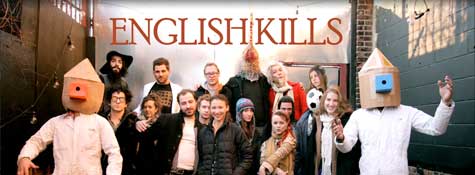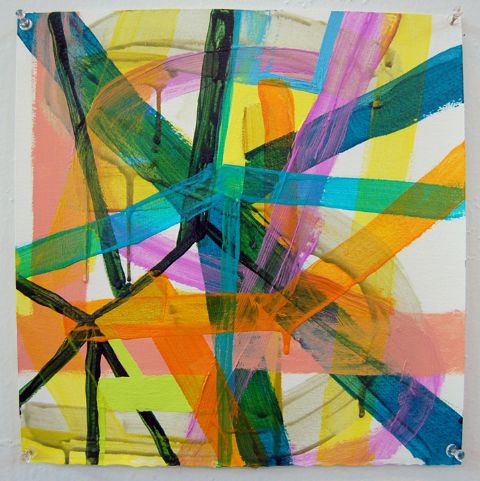
The constant flowering of bohemia is not a construct of advertising, nor of the whims of a dozen infamous gallerists. It is the generational engine of youth culture, alive and well, striving at the border of the mainstream, throwing out its various statements while at the same time contributing to a community that has registered a similar creative echo for at least 25 years.
Bushwick is the locus of new creative energies, the same ones that are active in many other parts of Brooklyn, especially its neighboring wards of Williamsburg and Greenpoint. This year saw the emergence of its first official celebration, The Bushwick Biennial, brainchild of NURTUREart gallery director Benjamin Evans, in collaboration with Austin Thomas of Pocket Utopia, Chris Harding of English Kills, and Jill McDermid of Grace Exhibition Space.

I first heard Ben utter these two words over a year ago, and since then he has worked hard to make it a reality. As the director of NURTUREart, he has seen first-hand what sort of influence the art community as a whole can exert when given proper focus within the scheme of the larger art world. Certainly the word ‘Williamsburg’ echoes out into the international art world, and so should its generative offspring. Just as Soho created the possibilities for Tribeca and Noho, Williamsburg has spread into the outlying areas of Greenpoint and Bushwick, and further, all along the corridors of the L train and the B61 Bus, and into the minds of New Yorkers, Americans, and people around the world.
Each of the three galleries I visited that weekend had a different focus of interest. The show Fortress to Solitude (an event that was actually part of the yearly organized Bushwick Open Studios, overlapping this year with the Biennial), curated in an independent studio space by Guillermo Creus and hosted by Brooklyn Fireproof landlord Burr Dodd, featured the work of some 22 artists, many of them working out the formal strategies of abstraction, some figurative, and some with text and a combination of elements.
Paintings by Amanda Church, Peter Fox, Lisha Bai, and Anna Pedersen presented drippy phantasms that were either visceral, limpid, or gossamer. Other abstract works were more structurally based, combining radically different mediums such as oil and spray paint (Guillermo Creus, Baptiste Ibar), making naturalistic allusions (Diane Carr), and stretching into hard edge materialism (Tom Meacham, Gary Petersen).

Another work by Peter Fox is a pale light blue canvas with two words painted in bold red letters, spelling out the expression ‘Idiot proof’, which is to say, anyone can get my art, and anyone could have made it. One very iconic portrait of President Obama by Tom Sanford is overlaid with the words What You Believe Is Already True emblazoned over a half quizzical facial expression of our fearless leader; is this just sloganeering, is the artist poking fun at authority, or is this just a painting about painting? Perhaps we will never know.
The title of this exhibition, a play on words originally describing the re-birthed spiritual home of the comic book legend Superman, is a telling narrative about the nature of creativity and how it is specifically vested in areas such as Bushwick. The overwhelming presence of abstraction in the exhibition can be characterized not only as the aesthetic bent of its curator (a painter himself), but also as a statement on the manic focus of Bushwick artists, whose concern is with forms of expression, and though they are a fairly idealistic bunch, such values do not always lead them down the primrose path of ideology. They remain committed to the formalism which inspires them.
Hung randomly with a lot of white space between them, we get the effect that spatial concerns still matter in the Bushwick of 2009 as they did in the Soho of 1969, and that giving artists room to think, and showing their work as existing within a systematic but disinterested locality is the best thing for them.
Finally Utopic is not just a pun, it’s the last show in the space that was once the studio of its director, the conceptual artist Austin Thomas, and features work by all the artists she has championed since her project began only two years ago. It has always existed as a sort of playground for artistic intentions, not taking itself too seriously, looking at art as if it were a form of conversation rather than a political slogan or commercial advertisement.

Molly Larkey, who is usually a sculptor, here presents gestural rather slapdash gouaches that intimate the beginnings of an idea that may later take physical form; Valerie Hegarty cracks the plaster of the wall before pasting a poster over the hole, that will ultimately rip the image along its ragged edge; Rico Gatson installs Systemic Risk Funky Revolution that is one part tautology and one part puzzle. The air overall is one of tentativeness, as if no one statement should predominate and none will last beyond the end of the space itself.
A strong tenor of idealism was evident in works at NURTUREart, curated by Benjamin Evans, though this motif was not always comprehensible in the same way; the works here were by and large non-abstract, or at least not within the limits of a formalist bent.

His own curatorial statement states that “These fourteen artists involve both optimism and melancholy, and reflect the tensions between doomed worlds, better places and personal mythologies." Themes of transformation and strategies of transformative experience run through the work and link it to the neighborhood that is transforming all around (and partly because of) them.
Mike Estabrook’s video loop The Road to 'Nam is both entertaining and pensive, as it combines images of brutality in war and the dour countenances of Kissinger and Nixon with a Bob Hope and Bing Crosby song "If I Knew You Were Coming I’d Of Baked A Cake." We recognize the images from the front page of The New York Times, of a US Okie aiming his gun at a Viet Cong, with politicians thrown in for good visual sense; but the whole arrangement falls apart with the song resounding. It’s so cheery and chummy that war can almost be seen as a big party in which we laugh until we have to cry.


Audrey Russel made a special installation on the adjoining rooftop that created a visual and physical spectacle which gallery guests had to step around as they talked, drank, and shared their experiences of the past evening’s activities. Made from pink foam insulation, a large wooden pylon and Xmas lights, Beam Tower with Pink Grass waved around the roof like the froth of an ever renewing tide. There is something very energizing about always living on the edge, engaging with what seems newly relevant. The Bushwick phenomenon has us looking for the next aesthetic event around every corner.
James Kalm for video of the
James Kalm
for video of the Bushwick Biennial check out:
http://www.youtube.com/watch?v=x60JRbzfUnA&feature=channel_page